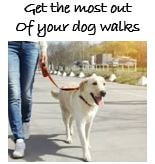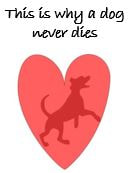Can Dogs Eat Bread?
www.akc.org
(Amercian Kennel Club - a lot of really good articles and they also offer a free ebook giving tips which we have inserted at the bottom - do pay a visit)
www.akc.org
(Amercian Kennel Club - a lot of really good articles and they also offer a free ebook giving tips which we have inserted at the bottom - do pay a visit)
I can’t count the number of times I’ve seen dogs eat sandwiches, slices, and even whole loaves of bread, and in one notable instance, an entire pack of English muffins. Bread makes up a large part of the American diet, and our dogs seem to get their fair share of it—but should they?
The short answer to the question "can dogs eat bread?" is yes. Dogs can safely eat bread in much the same way as humans—in moderation. Plain white and wheat bread is generally safe for dogs to eat, provided they don’t have any allergies, and it usually does not cause any stomach upset.
Feeding your dog bread as a treat now and then won’t hurt her, as long as she is also fed a complete and balanced diet and gets plenty of exercise. It also won’t help her. Bread is essentially a filler food and does not contain any nutrients that are not already supplied by your dog’s food. As anyone who has ever considered going on a diet knows, bread is full of carbs, which can put your dog on the path to obesity if you are not careful.
Risks of Feeding Bread to Dogs
The long answer to the question is a little more complicated. Bread itself is usually not toxic, but there are exceptions. Here is what you need to know about the risks of feeding bread to dogs to make sure your dog stays happy and healthy.
Dangerous Bread Dough
If you’ve ever made bread from scratch, then you know that dough has to rise, preferably in a warm, moist, draft-free environment. Unfortunately for dogs that are fed bread dough, their stomachs offer optimum conditions for rising dough.
The Merck Veterinary Manual lists bread dough as a food hazard for dogs. When a dog eats bread dough, the yeast in the dough continues to make the dough rise, distending his stomach and releasing toxic levels of ethanol into the dog’s bloodstream. The pressure of the rising dough can mimic and cause bloat, but the real danger is from the alcohol toxicosis. If your dog is fed bread dough or you suspect he has stolen bread dough, call your veterinarian immediately and look out for symptoms of alcohol toxicosis:
Toxic Bread Ingredients
Unless your dog has an allergy to wheat, plain white or wheat bread probably won’t hurt her. Not all breads are as harmless. Some breads contain toxic ingredients that should never be fed to dogs.
The biggest danger comes from raisins. Raisins are highly toxic and are often found in breads and baked goods. Veterinarians don't know why some dogs are more susceptible to raisins than others, but even a few raisins can cause problems. Raisin breads should be kept out of the reach of dogs at all times and should not be fed as a treat, even if the part you are feeding does not contain raisins.
Garlic is another ingredient found in bread that can be toxic to dogs. Garlic bread might tempt your dog’s nose, but garlic can cause serious side effects, like abdominal pain, vomiting, diarrhea, weakness, and collapse.
Some breads contain nuts and seeds, which appeal to humans for their flavor and health benefits, but can cause problems for dogs. The biggest nut danger is macadamia nuts, but even "safe" nuts and seeds can lead to stomach irritation and pancreatitis, thanks to their high fat content.
Xylitol is an artificial sweetener that is growing in popularity. It is most commonly found in sugar-free chewing gum and, more recently, certain brands of peanut butter and baked goods. While harmless to humans, xylitol is toxic to dogs. If you feed your dog bread or baked goods on a regular basis, be sure to check the ingredients, and also double check your peanut butter ingredients before you share your peanut butter and (grape-free) jelly sandwich.
Is Bread Good for Dogs With Upset Stomachs?
You may have heard people tell you that bread is good for dogs with upset stomachs. While this may sometimes be the case, the Merck Veterinary Manual recommends feeding a bland diet of rice and boiled chicken for dogs with upset stomachs, or better yet, calling your veterinarian for expert advice.
Learn more about the best foods for dogs with sensitive stomachs.
As with any table scrap, bread adds calories to your dog’s diet. If your dog is overweight, talk to your veterinarian about moderating her diet and discuss a plan to keep her healthy, happy, and active. Bread packs a high glycemic punch and is high in calories, so feed your dog only very small pieces of bread at a time to avoid obesity-related diseases, like diabetes.
The short answer to the question "can dogs eat bread?" is yes. Dogs can safely eat bread in much the same way as humans—in moderation. Plain white and wheat bread is generally safe for dogs to eat, provided they don’t have any allergies, and it usually does not cause any stomach upset.
Feeding your dog bread as a treat now and then won’t hurt her, as long as she is also fed a complete and balanced diet and gets plenty of exercise. It also won’t help her. Bread is essentially a filler food and does not contain any nutrients that are not already supplied by your dog’s food. As anyone who has ever considered going on a diet knows, bread is full of carbs, which can put your dog on the path to obesity if you are not careful.
Risks of Feeding Bread to Dogs
The long answer to the question is a little more complicated. Bread itself is usually not toxic, but there are exceptions. Here is what you need to know about the risks of feeding bread to dogs to make sure your dog stays happy and healthy.
Dangerous Bread Dough
If you’ve ever made bread from scratch, then you know that dough has to rise, preferably in a warm, moist, draft-free environment. Unfortunately for dogs that are fed bread dough, their stomachs offer optimum conditions for rising dough.
The Merck Veterinary Manual lists bread dough as a food hazard for dogs. When a dog eats bread dough, the yeast in the dough continues to make the dough rise, distending his stomach and releasing toxic levels of ethanol into the dog’s bloodstream. The pressure of the rising dough can mimic and cause bloat, but the real danger is from the alcohol toxicosis. If your dog is fed bread dough or you suspect he has stolen bread dough, call your veterinarian immediately and look out for symptoms of alcohol toxicosis:
- Depressed central nervous system
- Weakness
- Depression
- Unsteady, drunken gait
- Hypothermia
- Seizures
- Coma
Toxic Bread Ingredients
Unless your dog has an allergy to wheat, plain white or wheat bread probably won’t hurt her. Not all breads are as harmless. Some breads contain toxic ingredients that should never be fed to dogs.
The biggest danger comes from raisins. Raisins are highly toxic and are often found in breads and baked goods. Veterinarians don't know why some dogs are more susceptible to raisins than others, but even a few raisins can cause problems. Raisin breads should be kept out of the reach of dogs at all times and should not be fed as a treat, even if the part you are feeding does not contain raisins.
Garlic is another ingredient found in bread that can be toxic to dogs. Garlic bread might tempt your dog’s nose, but garlic can cause serious side effects, like abdominal pain, vomiting, diarrhea, weakness, and collapse.
Some breads contain nuts and seeds, which appeal to humans for their flavor and health benefits, but can cause problems for dogs. The biggest nut danger is macadamia nuts, but even "safe" nuts and seeds can lead to stomach irritation and pancreatitis, thanks to their high fat content.
Xylitol is an artificial sweetener that is growing in popularity. It is most commonly found in sugar-free chewing gum and, more recently, certain brands of peanut butter and baked goods. While harmless to humans, xylitol is toxic to dogs. If you feed your dog bread or baked goods on a regular basis, be sure to check the ingredients, and also double check your peanut butter ingredients before you share your peanut butter and (grape-free) jelly sandwich.
Is Bread Good for Dogs With Upset Stomachs?
You may have heard people tell you that bread is good for dogs with upset stomachs. While this may sometimes be the case, the Merck Veterinary Manual recommends feeding a bland diet of rice and boiled chicken for dogs with upset stomachs, or better yet, calling your veterinarian for expert advice.
Learn more about the best foods for dogs with sensitive stomachs.
As with any table scrap, bread adds calories to your dog’s diet. If your dog is overweight, talk to your veterinarian about moderating her diet and discuss a plan to keep her healthy, happy, and active. Bread packs a high glycemic punch and is high in calories, so feed your dog only very small pieces of bread at a time to avoid obesity-related diseases, like diabetes.
|
In addition to your daily walk being a wonderful experience for your dog, you can make it even more fun by bringing in an element of training - supplies mental stimulation and increases your bond - plus makes for an even better behaved dog!
|
Some of you, particularly those who think they have recently lost a dog to ‘death; don’t really understand this. I’ve no desire to explain, but won’t be around forever and must.
|
Some of you, particularly those who think they have recently lost a dog to ‘death; don’t really understand this. I’ve no desire to explain, but won’t be around forever and must.
|







